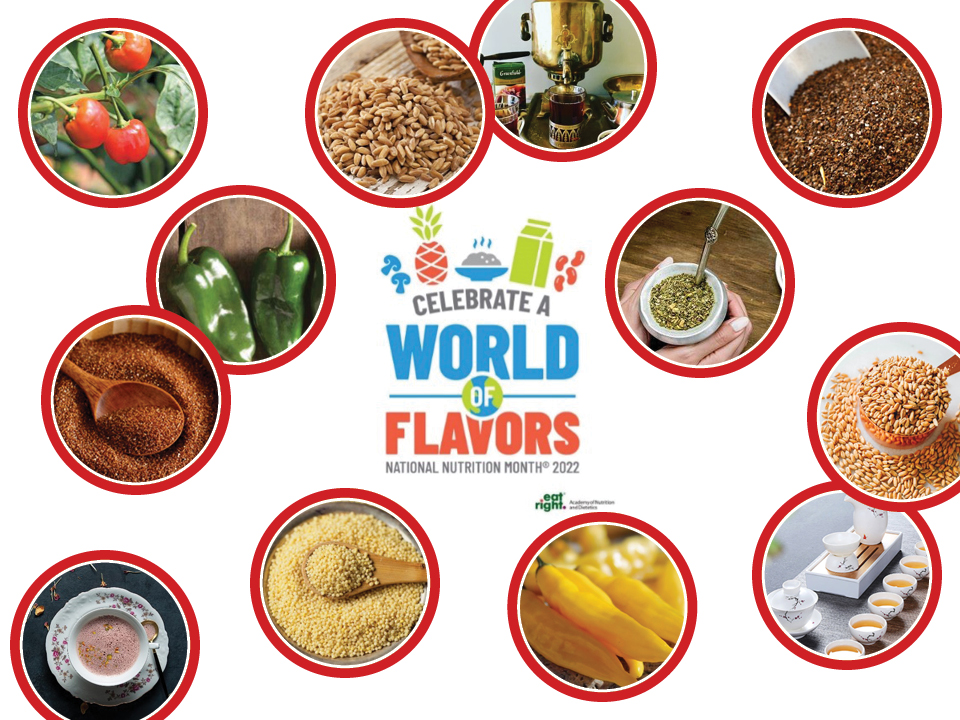
Archived Story: This article is part of our newsletter archives. It has
been preserved for reference, but the information may no longer be current.
written by Dani Higgins, student intern with Dining Services
March is National Nutrition Month and this year’s theme, “Celebrate a World of Flavors,” reminds us to try different ingredients and cuisines to expand our palettes and learn more about the world around us. Here are three categories that might be a great place to start when it comes to trying something new: peppers, teas, and grains.
PEPPERS
Pepper is a flavor that is used in almost all cultures; however, the type of pepper used is different across the world. Here are a few peppers to try and how they are used in different countries.
- Peppadew piquanté peppers, South Africa | Often sweeter and milder than typical peppers, this cherry-sized treat is eaten as a snack or used on sandwiches, pizzas, and salads.
- Lemon drop chili, Peru | Commonly used in dishes to add a lemony flavor that is tangy and spicy, the lemon drop pepper is commonly used in Peruvian soups and stir-fries.
- Isot pepper, Turkey | Produced in southeast Turkey and said to have a smokey, sweet flavor, it can be compared to cayenne pepper and is used as a seasoning spice on many vegetables, meats, and other dishes.
- Poblano pepper, Mexico | A common pepper used in many dishes in Mexico, this is a combination of jalapenos and sweet peppers and can be dried to make ancho chilies, which have fruity flavor and are sued to make chili sauce.
Additional resource: theculturetrip.com
TEAS
Drinking tea originated in China almost 4,700 years ago and is an activity that is now done around the world. Here are a few common types of tea enjoyed across the world.
- Yerba mate, Argentina | Made from the titular herb, this tea is brewed in a large pot or a dried gourd, contains caffeine, and is drunk through a bombilla which is a special straw that strains the liquid from the herbs when drinking.
- Zavarka, Russia | From the early 1900’s, this tea originated during a teas shortage during the Russian Civil War in which Russians would make a large pot of tea in a samovar. Often served with milk, sugar, cookies, crackers, and cake, this tea is very concentrated, and guests only fill their cup with an inch of tea then fill the rest with hot water.
- Gongfu tea, China | A traditional tea ceremony that begins with guests smelling the tea leaves before they are brewed, guests small amounts of tea to savor the flavor then are invited to hold on to their empty cup to smell the tea aroma.
- Noon chai, Pakistan | Originally from Kashmir, which is a country north of Pakistan, this drink is commonly offered to guests in Pakistan as a symbol of respect and is a green tea that has been added salt, milk, and baking soda which gives it a pink color.
Additional resource: mentalfloss.com
GRAINS
Whole grains are grains that are not processed and still include the bran, germ and endosperm of the grain. Whole grains originate from all over the world.
- Millet, India | Grown for thousands of years in varieties such as pearl, foxtail, and fonio, millet is a gluten-free grain that can be used as a flour or cooked whole in a variety of dishes offering a good source of protein and fiber.
- Farro, Italy | From the ancient grain, emmer, which was commonly eaten in the Roman Empire, this grain has a nutty flavor and is commonly used in many Italian dishes, such as farrotto and zuppa di farro.
- Spelt, Gremany | First grown in Germany starting in 4,000 BCE, spelt is commonly used as flour as it contains a high amount of protein, and is used in pizza dough, bread and soups.
- Teff, Ethiopia | This very small grain was first grown in Ethiopia around 6,000 years ago. It can be red, brown or white; and often has a sweet molasses flavor.
Additional resources: wholegraincouncil.org | masterclass.com